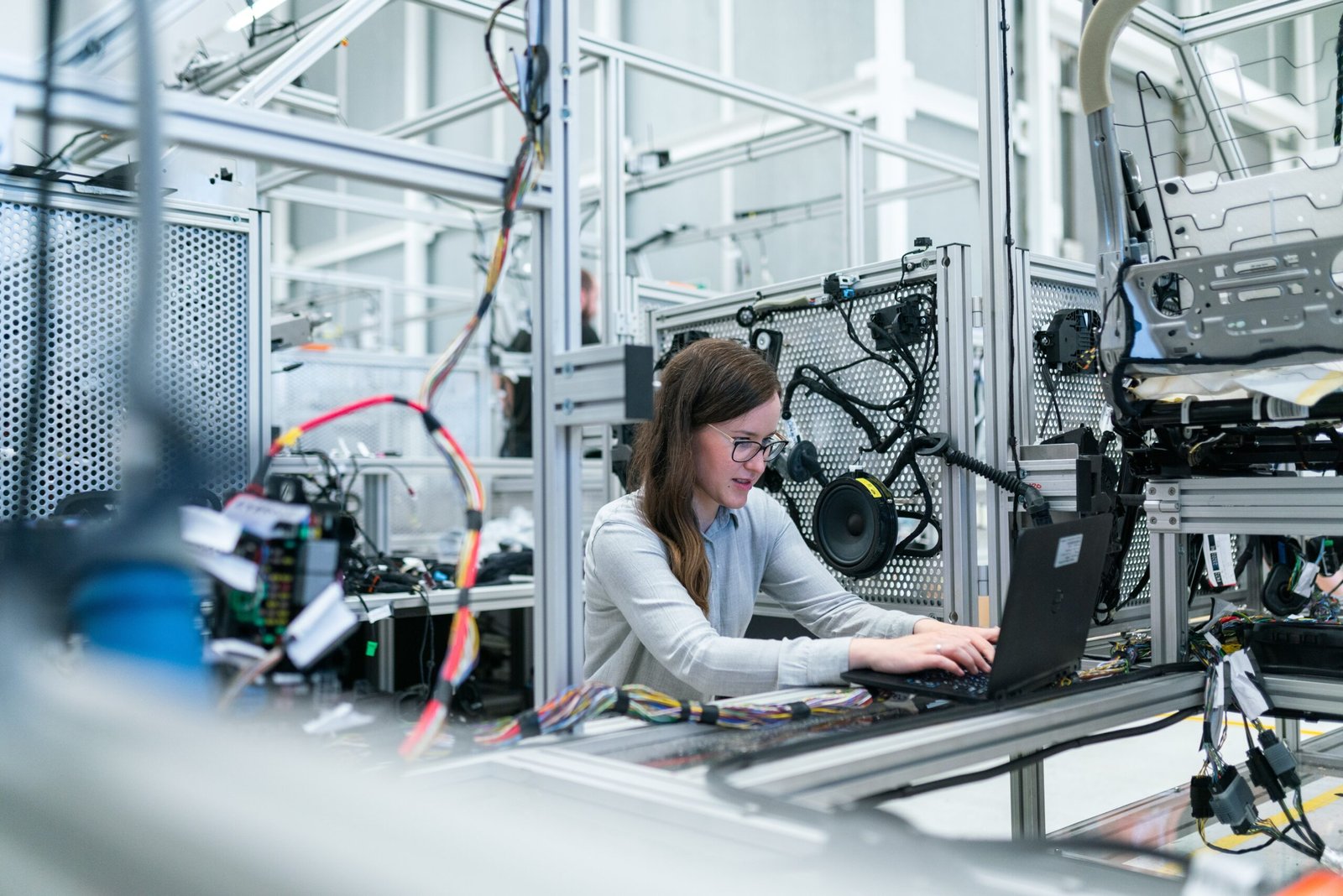Imagine a world where artificial intelligence comes to the rescue, aiding humanity in the ongoing battle against climate change. Can AI, with its unmatched capabilities and potential, truly help in reducing carbon emissions? This question has sparked significant interest and debate among scientists, policymakers, and environmentalists alike. As we delve into this fascinating topic, let’s explore the potential applications of AI in mitigating the effects of greenhouse gas emissions and paving the way for a more sustainable future.
The Role of AI in Reducing Carbon Emissions

This image is property of images.unsplash.com.
Understanding the Potential of AI in Carbon Emission Reduction
With the rising concerns about climate change and the urgent need for sustainable practices, the role of artificial intelligence (AI) in reducing carbon emissions has gained significant attention. AI has the potential to revolutionize the way we address climate change by optimizing energy production and consumption, enhancing renewable energy integration, reducing energy consumption and waste, monitoring and analyzing emission data, enabling behavioral changes and public engagement, facilitating policy formulation and decision-making, and fostering collaborative solutions. By leveraging the power of AI, we can pave the way towards a greener and more sustainable future.
Challenges in Reducing Carbon Emissions
Despite the potential benefits, there are several challenges in reducing carbon emissions that need to be addressed. One of the key challenges is the complexity and interconnectedness of the global energy systems. The integration of renewable energy sources, such as solar and wind, into the existing energy grid poses technical and operational challenges that require innovative solutions. Additionally, changing behavior patterns and habits of individuals and industries is not an easy endeavor. Cultural and economic factors can hinder the adoption of sustainable practices. Furthermore, policy-making and decision-making processes need to be informed by accurate and reliable data, which may be limited or difficult to obtain. Overcoming these challenges requires a multidisciplinary approach and the application of advanced technologies, such as AI, to develop effective strategies for carbon emission reduction.
How AI Can Contribute to Carbon Emissions Reduction
AI has the potential to contribute to carbon emissions reduction in various ways. By harnessing the power of AI, we can optimize energy production and consumption, enhance the integration of renewable energy sources, reduce energy consumption and waste, monitor and analyze emission data, enable behavioral changes and public engagement, facilitate policy formulation and decision-making, and foster collaborative solutions.
Applications of AI in Energy Management and Efficiency
Using AI to Predict Energy Demand and Optimize Generation
AI can be utilized to predict energy demand and optimize the generation of electricity. By analyzing historical data, weather patterns, and other relevant factors, AI algorithms can accurately forecast energy demand and supply. This enables power plants to adjust their generation schedules accordingly, ensuring a balance between supply and demand and minimizing wastage. By avoiding over-generation and unnecessary energy production, we can significantly reduce carbon emissions.
Smart Grid Management and Load Balancing
AI-powered smart grid management systems can optimize the distribution and consumption of electricity. These systems can monitor and analyze real-time data from smart meters and other sensors to ensure efficient distribution and load balancing. By dynamically adjusting the power flow and rerouting electricity to areas with higher demand, AI can reduce energy wastage and improve the overall efficiency of the grid. This not only reduces carbon emissions but also enhances the reliability and resilience of the energy infrastructure.
AI-Powered Energy Efficient Buildings and Appliances
AI can also play a crucial role in improving energy efficiency in buildings and appliances. Smart building management systems, equipped with AI algorithms, can optimize energy usage by monitoring and adjusting heating, cooling, and lighting systems based on occupancy and weather conditions. AI can also analyze data from smart appliances to identify usage patterns and recommend energy-saving measures. By implementing AI-driven energy management systems, we can significantly reduce energy consumption and carbon emissions in residential, commercial, and industrial sectors.

This image is property of images.unsplash.com.
Enhancing Renewable Energy Integration
The Role of AI in Improving Integration of Renewable Energy Sources
One of the key challenges in transitioning to a renewable energy-powered future is the efficient integration of renewable energy sources into the existing energy grid. AI can help overcome this challenge by optimizing the integration process. AI algorithms can analyze data from various sources, including weather forecasts, solar irradiance measurements, and wind speed data, to predict renewable energy generation. This enables grid operators to plan and manage the integration of renewable energy sources more effectively, reducing the reliance on fossil fuels and minimizing carbon emissions.
AI-Driven Forecasting for Renewable Energy Generation
Another way AI can enhance renewable energy integration is through accurate forecasting of renewable energy generation. By analyzing historical data, weather patterns, and other relevant variables, AI algorithms can generate precise forecasts of renewable energy generation. These forecasts can assist grid operators in balancing the demand and supply of electricity, optimizing energy storage and distribution, and reducing the need for backup fossil fuel-based generation. By utilizing AI-driven forecasting, we can maximize the utilization of renewable energy sources and minimize the reliance on carbon-intensive energy generation.
Optimizing Renewable Energy Distribution and Storage through AI
AI can also optimize the distribution and storage of renewable energy. By analyzing real-time data on energy demand, supply, and storage capacity, AI algorithms can optimize the routing of electricity and manage energy storage systems. This ensures that renewable energy is distributed and utilized efficiently, reducing wastage and improving the overall reliability and stability of the grid. Additionally, AI can optimize the charging and discharging cycles of energy storage systems, prolonging their lifespan and reducing the reliance on conventional energy sources.
Reducing Energy Consumption and Waste
AI-Based Smart Transportation Systems
Transportation is a significant contributor to carbon emissions. AI can play a vital role in reducing energy consumption and emissions in the transportation sector. AI-powered transportation systems can optimize traffic flow, reduce congestion, and minimize fuel consumption. By analyzing real-time traffic data, AI algorithms can optimize traffic signal timings, recommend optimal routes to drivers, and facilitate the efficient use of public transportation. Moreover, AI can be leveraged to develop autonomous vehicles that are more energy-efficient and produce fewer emissions.
Optimizing Supply Chain and Logistics with AI
AI can also optimize supply chain and logistics operations, reducing energy consumption and waste. By analyzing data on inventory levels, transportation routes, and demand patterns, AI algorithms can optimize delivery schedules and routes, minimizing fuel consumption and emissions. Furthermore, AI can enhance demand forecasting accuracy, improving inventory management and reducing the need for excess production. By optimizing supply chain and logistics processes, AI can contribute to significant energy savings and emissions reduction across industries.
AI Applications in Industrial Process Optimization
Industrial processes are often energy-intensive and contribute significantly to carbon emissions. AI can optimize industrial processes by analyzing real-time data on equipment performance, energy usage, and production variables. AI algorithms can identify energy inefficiencies, recommend process modifications, and optimize equipment operations to minimize energy consumption and emissions. By harnessing AI for industrial process optimization, we can drive significant energy savings and reduce the carbon footprint of industrial operations.

This image is property of images.unsplash.com.
Monitoring and Analyzing Emission Data
Real-Time Emission Monitoring Tools Powered by AI
Monitoring and analyzing emission data is crucial for identifying emission sources, evaluating the effectiveness of emission reduction strategies, and informing policy decisions. AI can automate the process of emission monitoring by analyzing real-time data from sensors and satellites. By leveraging AI algorithms, we can detect and quantify emissions from various sources, such as industrial facilities, transportation systems, and power plants. Real-time emission monitoring powered by AI provides valuable insights into emission patterns, allowing for timely interventions and targeted mitigation measures.
Using AI to Analyze Massive Amounts of Environmental Data
With the increasing availability of environmental data, there is a need for advanced analytical tools to process and analyze large datasets. AI can play a vital role in analyzing massive amounts of environmental data, such as satellite imagery, weather data, and sensor readings. By applying machine learning algorithms, AI can identify patterns, correlations, and trends in the data, enabling us to better understand the drivers of carbon emissions and formulate effective strategies for reduction. AI-driven analysis of environmental data provides valuable insights that can inform policy-making, resource allocation, and emissions reduction efforts.
Predictive Modeling for Emissions Reduction Strategies
AI can also be utilized for predictive modeling of emissions reduction strategies. By combining historical emission data, environmental variables, and other relevant factors, AI algorithms can simulate and predict the impacts of different strategies and interventions. This allows policymakers to evaluate the effectiveness of various measures, identify potential risks and opportunities, and design evidence-based emissions reduction strategies. AI-driven predictive modeling provides a powerful tool for decision-making, helping us develop targeted and impactful interventions for carbon emissions reduction.
Enabling Behavioral Changes and Public Engagement
AI-Driven Personal Carbon Footprint Tracking and Recommendations
AI can empower individuals to make sustainable choices and reduce their carbon footprint. By using AI-powered applications, individuals can track their personal carbon footprint based on their lifestyle choices, energy consumption, transportation habits, and dietary preferences. AI algorithms can provide personalized recommendations for reducing carbon emissions, such as choosing energy-efficient appliances, adopting sustainable transportation options, or making eco-friendly purchasing decisions. AI-driven personal carbon footprint tracking and recommendations encourage behavioral changes, empowering individuals to contribute to carbon emissions reduction at the grassroots level.
Gamification and Incentivizing Sustainable Behaviors through AI
Gamification is a powerful tool for engaging and motivating individuals towards sustainable behaviors. AI can leverage gamification principles to incentivize and reward sustainable actions. By incorporating AI algorithms, applications can provide personalized challenges, real-time feedback, and virtual rewards for adopting sustainable practices. Gamifying sustainability through AI creates a fun and interactive experience that encourages individuals to make sustainable choices and reduce their carbon footprint.
Enhancing Public Awareness and Education with AI
AI can also enhance public awareness and education on the importance of carbon emissions reduction and sustainability. Through AI-powered platforms, individuals can access educational content, real-time environmental data, and interactive tools that illustrate the impact of their choices on carbon emissions. AI algorithms can personalize the information based on individual preferences, making it more engaging and relevant. By leveraging AI for public awareness and education, we can empower individuals and communities to take informed actions towards a sustainable future.
Policy Formulation and Decision-Making
AI Integration in Policy Modeling and Scenario Analysis
Policy formulation and decision-making require thorough analysis of complex data and consideration of various factors. AI can assist in the integration of vast amounts of data and the modeling of different policy scenarios. By utilizing machine learning algorithms, policymakers can simulate the impacts of different policy interventions on carbon emissions, economic growth, and societal well-being. AI-driven policy modeling and scenario analysis can provide valuable insights into the potential outcomes and trade-offs of different policy options, enabling evidence-based decision-making for carbon emissions reduction.
Automating Carbon Footprint Calculations and Certifications
AI can automate the calculations and certifications of carbon footprints for individuals, organizations, and products. By analyzing data on energy consumption, emission sources, and other relevant variables, AI algorithms can accurately calculate carbon footprints. Automated carbon footprint certifications can streamline the process and ensure consistency and reliability in the assessment of carbon emissions. By automating carbon footprint calculations and certifications, AI can encourage transparency, accountability, and informed decision-making towards carbon emissions reduction.
Leveraging AI for Carbon Pricing and Emissions Trading
AI can also play a significant role in implementing carbon pricing mechanisms and emissions trading systems. By analyzing historical emissions data, market trends, and other relevant factors, AI algorithms can determine the optimal carbon prices and facilitate emissions trading. AI can automate the monitoring, reporting, and verification processes, ensuring the accuracy and integrity of emissions trading. By leveraging AI for carbon pricing and emissions trading, we can incentivize emission reductions, promote market-based approaches, and drive sustainable economic growth.
Collaborative AI Solutions for Carbon Reduction
The Importance of Collaboration in Reducing Carbon Emissions
Addressing the challenge of carbon emissions reduction requires collaboration across various stakeholders, including governments, businesses, research institutions, and communities. AI can foster collaboration by providing platforms for sharing knowledge, best practices, and innovative solutions. The integration of AI into collaborative platforms enables stakeholders to access and contribute to a collective pool of expertise, accelerating the development and implementation of effective carbon reduction strategies.
AI-Driven Platforms for Sharing Knowledge and Best Practices
AI-powered platforms can facilitate the sharing of knowledge and best practices in carbon emissions reduction. By utilizing AI algorithms, these platforms can curate and recommend relevant resources, conduct data analysis, and facilitate communication and collaboration among stakeholders. AI-driven platforms enable the dissemination of up-to-date information, the exchange of ideas, and the replication of successful initiatives, promoting collective learning and continuous improvement in carbon reduction efforts. By harnessing the power of AI for knowledge sharing, we can accelerate progress towards a low-carbon future.
Collaborative AI Solutions in Carbon Capture and Storage
Collaborative AI solutions can also accelerate advancements in carbon capture and storage (CCS) technologies. CCS plays a crucial role in mitigating carbon emissions by capturing and permanently storing carbon dioxide from industrial processes and power generation. AI can facilitate collaboration between researchers, engineers, and industry experts, enabling the development of more efficient and cost-effective CCS technologies. By leveraging AI for collaborative research and development, we can accelerate the deployment of CCS solutions and contribute to significant reductions in carbon emissions.
Overcoming Challenges and Ethical Considerations
Addressing Data Quality and Bias in AI Applications
The success of AI in carbon emissions reduction depends on the availability of high-quality, diverse, and unbiased data. Data quality issues, such as incomplete or inaccurate data, can undermine the effectiveness of AI algorithms and lead to erroneous conclusions and recommendations. Bias in data, such as overrepresentation of certain demographics or geographic areas, can result in unfair or discriminatory outcomes. To overcome these challenges, efforts must be made to ensure data quality, diversity, and representativeness. Furthermore, ethical considerations, such as privacy and consent, should be incorporated into the design and implementation of AI systems for carbon emissions reduction.
Ensuring the Security and Privacy of AI-Driven Systems
As AI becomes more integrated into carbon emissions reduction efforts, ensuring the security and privacy of AI-driven systems becomes crucial. The data used by AI algorithms, such as energy consumption patterns or personal carbon footprint information, must be safeguarded against unauthorized access or misuse. Additionally, the algorithms themselves need to be protected from malicious attacks or manipulation. Strong cybersecurity measures and privacy protection protocols should be implemented to maintain the integrity and trustworthiness of AI-driven systems.
Ethical Considerations in AI Decision-Making for Carbon Reduction
AI algorithms used for carbon emissions reduction can have significant societal impacts, and ethical considerations must be taken into account. The decisions made by AI algorithms, such as recommending specific actions or assigning carbon prices, can have far-reaching consequences. Transparency, explainability, and accountability are essential in AI decision-making processes to ensure fairness and avoid unintended biases or discriminatory outcomes. Ethical frameworks and guidelines should be established to guide the development and use of AI for carbon emissions reduction, promoting responsible and equitable practices.
Conclusion
In conclusion, AI has the potential to revolutionize the way we tackle the challenge of carbon emissions reduction. By optimizing energy production and consumption, enhancing renewable energy integration, reducing energy consumption and waste, monitoring and analyzing emission data, enabling behavioral changes and public engagement, facilitating policy formulation and decision-making, and fostering collaborative solutions, AI can drive significant progress towards a greener and more sustainable future. However, it is essential to address the challenges and ethical considerations associated with AI applications, such as data quality, security, privacy, and societal impact. By leveraging the power of AI responsibly and collaboratively, we can accelerate the transition to a low-carbon economy and mitigate the impacts of climate change for future generations.
